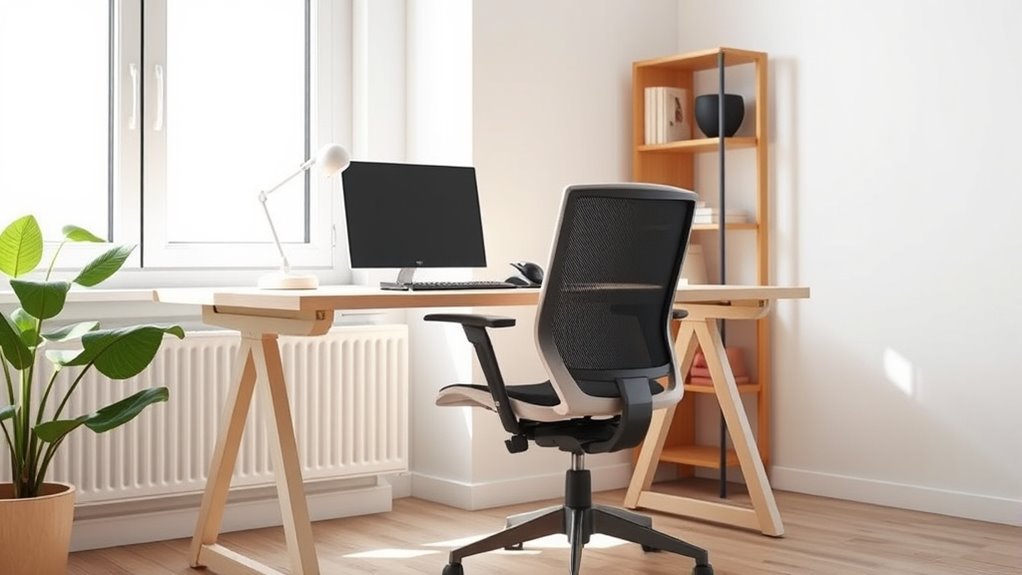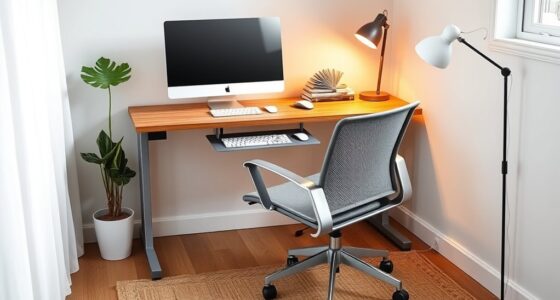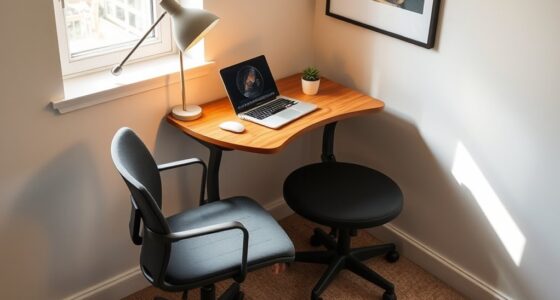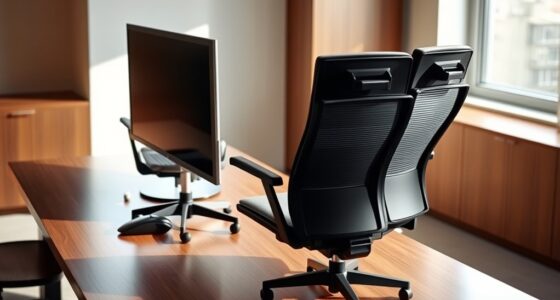To set up an ergonomic home office on a budget, focus on essential features like adjusting your desk height so your elbows stay at 90°, and positioning your monitor at eye level using household items like books or risers. Repurpose household items such as pillows and blankets for added support, choose affordable supportive chairs, and arrange your workspace for efficiency and comfort. Small budget-friendly accessories can further improve your posture—continue exploring for more tips to create a comfortable, productive space.
Key Takeaways
- Prioritize adjustable desk height and monitor positioning using affordable solutions like books or risers.
- Use household items such as pillows and blankets for lumbar support and cushioning.
- Choose supportive, adjustable chairs—secondhand options can offer ergonomic features at low cost.
- Arrange your workspace for easy access, proper lighting, and monitor at eye level to promote good posture.
- Add budget-friendly accessories like wrist rests or monitor risers to enhance ergonomic comfort.
Prioritize Key Ergonomic Features Without Overspending
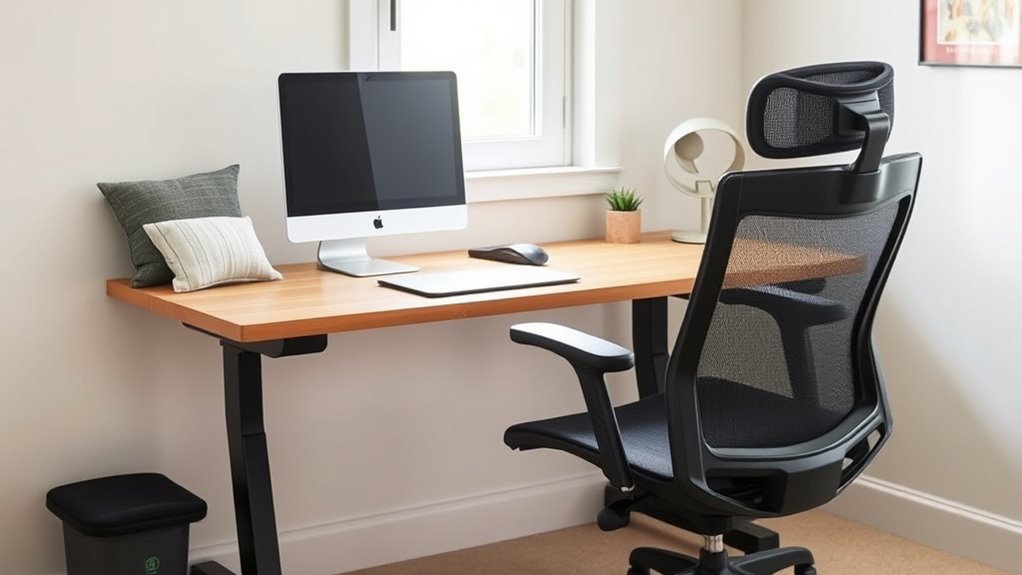
While it’s tempting to buy every ergonomic gadget on the market, focusing on the essentials will give you the best comfort without breaking the bank. Start by adjusting your desk height so your elbows are at a 90-degree angle when typing, reducing strain on your shoulders. Proper monitor placement is equally important; position your screen so the top is at eye level and about an arm’s length away. This prevents neck strain and encourages good posture. You don’t need fancy accessories—just a sturdy desk and a monitor stand or books to elevate your screen if needed. Ensuring these key features are set correctly makes a significant difference in comfort and productivity, all without overspending on unnecessary gadgets. Additionally, reviewing divorce statistics can remind you of the importance of planning and support systems when navigating major life changes.
Repurpose and Upcycle Household Items for Comfort
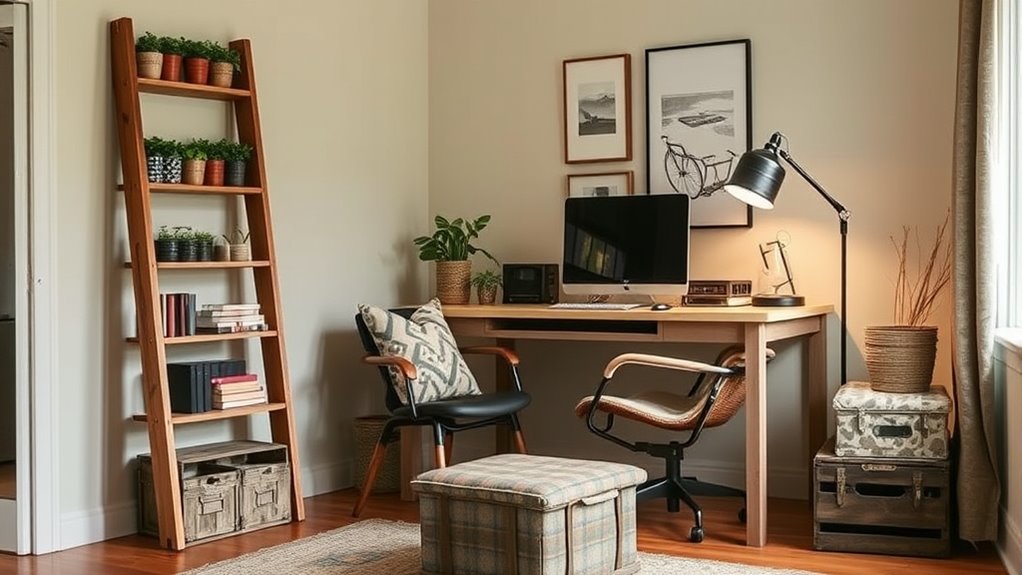
Instead of spending extra money on new ergonomic accessories, look around your home for items that can be repurposed to improve your workspace. You can create DIY decor that boosts comfort, like stacking hardcover books to elevate your monitor or using pillows for lumbar support. Repurposing household items also offers a chance to upgrade your environment with decorative lighting—string lights or battery-operated LEDs can add warmth and reduce eye strain. A cozy blanket draped over a chair can provide additional cushioning, while empty jars or tins can organize supplies. These simple projects not only save money but personalize your space, making it more inviting and functional. Incorporating Halloween-themed decor can add a fun and festive touch to your home office during the holiday season. Upcycling household items turns everyday objects into ergonomic tools, helping you craft an affordable, comfortable home office.
Choose Affordable, Supportive Seating Options
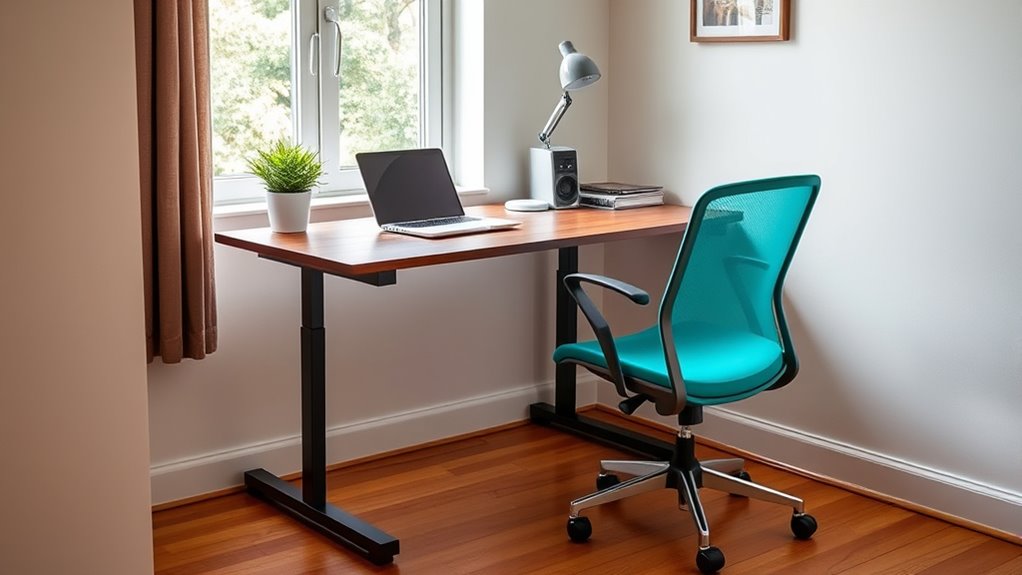
Finding affordable, supportive seating for your home office doesn’t mean you have to sacrifice comfort. Look for chairs with adjustable lumbar support to keep your lower back properly aligned during long work sessions. Cushioned armrests help reduce strain on your shoulders and elbows, making extended periods at your desk more comfortable. You don’t need to buy expensive ergonomic chairs; many budget-friendly options include these features. Focus on chairs that allow you to customize the height and support to fit your body. Consider secondhand or refurbished options, which often offer quality support at a lower cost. Remember, investing in supportive seating is essential for maintaining good posture and preventing discomfort, so prioritize adjustable lumbar support and cushioned armrests when choosing your budget-friendly office chair. Incorporating ergonomic features like adjustable support can significantly improve comfort and reduce fatigue during long work hours.
Optimize Your Workspace Layout for Efficiency and Well-being

Organizing your workspace layout can substantially boost your productivity and well-being by creating an environment that minimizes distractions and supports movement. Start by arranging your desk for easy access to essential items, enhancing desk organization. Proper lighting solutions, like natural light or adjustable lamps, reduce eye strain and improve focus. Position your monitor at eye level to promote good posture. Use the table below to balance your space efficiently:
| Zone | Function | Tips |
|---|---|---|
| Work Area | Main workspace | Keep essentials within reach |
| Storage | Organization and clutter control | Use shelves or drawers |
| Break Space | Rest and quick refreshes | Keep it clear and inviting |
This layout fosters a streamlined workflow while supporting your well-being. Incorporating ergonomic principles, such as proper desk setup, can further enhance comfort and reduce strain during long work hours.
Incorporate Budget-Friendly Accessories to Improve Posture
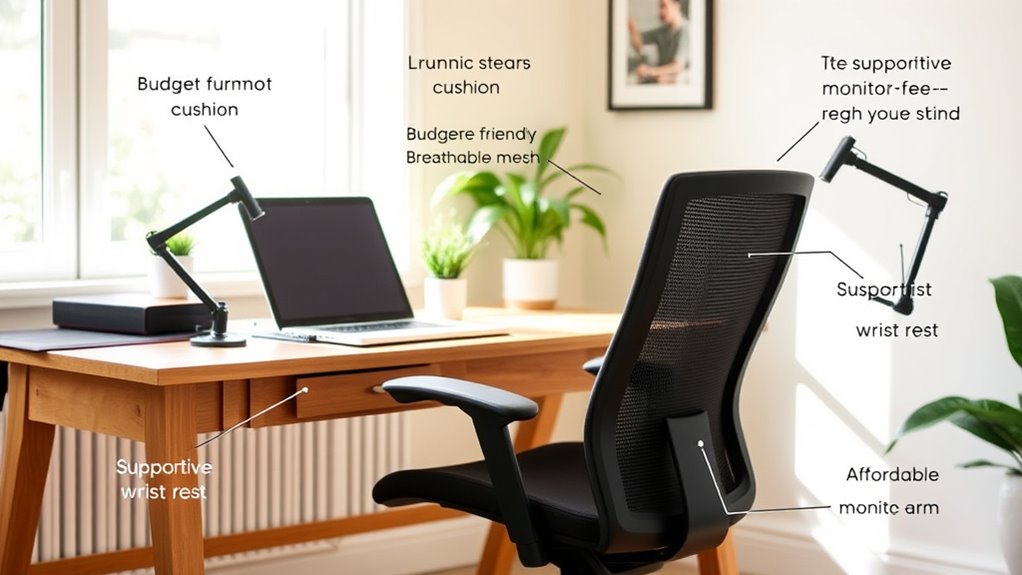
Improving your posture doesn’t have to cost a fortune; there are many budget-friendly accessories that can make a significant difference. Start with keyboard ergonomics—consider affordable wrist rests or angled keyboard stands to reduce strain. These simple additions promote better hand positioning and comfort. For monitor placement, use inexpensive risers or stacks of books to elevate your screen to eye level. Proper monitor height prevents neck strain and encourages good posture. Additionally, adjustable monitor arms are often available at low prices and allow you to position your screen perfectly. Small investments like these can transform your workspace, making it healthier without breaking the bank. Incorporating budget-friendly accessories ensures you maintain better posture, reduces discomfort, and boosts productivity.
Frequently Asked Questions
How Can I Ensure Proper Lighting in a Budget-Friendly Home Office?
You want to guarantee proper lighting in your home office without overspending. Start by choosing affordable lighting options like LED desk lamps or clip-on lights, which provide bright, adjustable illumination. You can also create DIY lighting solutions with inexpensive materials, such as using white foam boards to reflect light or repurposing existing lamps with brighter bulbs. These simple, budget-friendly tips help reduce eye strain and improve your workspace effectively.
Are There Cost-Effective Ways to Reduce Glare and Screen Fatigue?
Research shows that reducing glare and screen fatigue can boost your comfort and productivity. You can do this affordably by adjusting your screen position to avoid reflections and using anti-glare screens, which are often budget-friendly. Keep your monitor at eye level and make certain proper lighting to minimize glare. These simple steps make a significant difference without breaking the bank, helping you work comfortably for longer periods.
What Are Some DIY Solutions to Improve Airflow and Ventilation?
To improve airflow and ventilation in your home office, try DIY ventilation and airflow solutions. You can create simple solutions like placing a box fan near a window to promote cross-ventilation or use a small, homemade air purifier with activated charcoal and filters. Additionally, leaving interior doors open and using lightweight curtains helps increase air circulation, making your workspace more comfortable without spending much.
How Can I Maintain Cleanliness and Organization on a Tight Budget?
Imagine your workspace as a neat, calming oasis. You keep it tidy by establishing simple cleaning routines—wiping surfaces and decluttering weekly. Use affordable storage solutions like boxes or baskets to corral supplies, making everything easy to find. Regularly sorting and donating unused items keeps chaos at bay. With a little effort and smart organization, your home office remains clean and inviting, even on a tight budget.
What Are the Best Free or Low-Cost Resources for Ergonomic Tips?
You can find great free or low-cost ergonomic tips online, such as ergonomic chair reviews and desk height adjustment guides. These resources help you choose affordable furniture and set it up correctly, preventing discomfort. Look for reputable websites or videos from ergonomic experts. By applying these tips, you’ll create a comfortable workspace without overspending, making your home office healthier and more productive.
Conclusion
By focusing on essential ergonomic features and creatively repurposing household items, you can create a comfortable, efficient home office without breaking the bank. For instance, imagine using an old dining chair with added cushions for better support or adjusting your desk height with sturdy books. With some thoughtful choices, you’ll boost your posture and productivity. Remember, a well-designed workspace isn’t about expensive gear — it’s about making smart, budget-friendly improvements that work for you.
